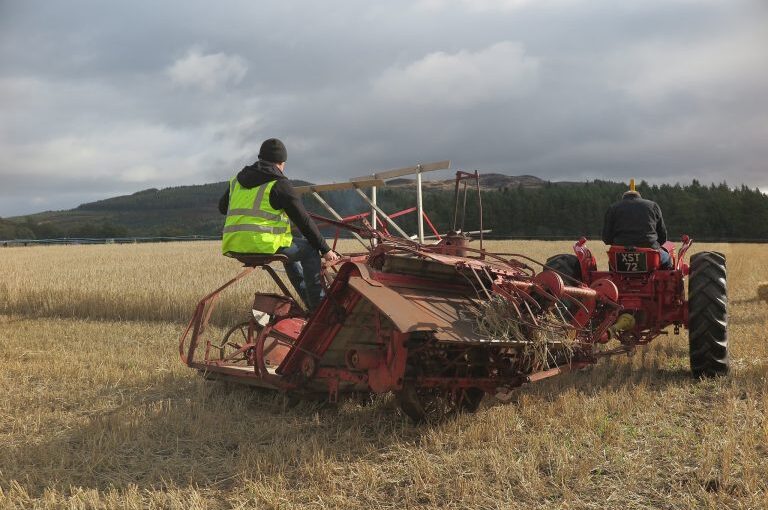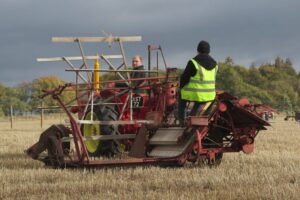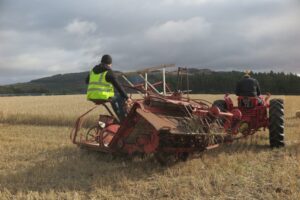There were lots of different opinions on the binder in Scotland in the early 1890s. These were included in accounts of trials and demonstrations, as well as correspondence to the agricultural and other newspapers. Farmers sometimes wanted to share their experiences of working with the binders in the agricultural press. They included a farmer in the county of Midlothian who called himself “A Mid-Lothian Farmer”. He wrote to the farming newpaper the “Farming World”. It was reprinted in the Linlithgowshire gazette of 26 September 1891. It is a practical and reflective account. It is worth quoting at length:
“The binder still imperfect
“A Mid-Lothian Farmer” writes to the Farming World as follows:-“In your copy of yesterday, notice is given of a trial of binders in the north, where five machines competed. The committee’s report of the trial, it says, will be presented in a few days. That report will be looked forward to both by the different makers and farmers generally with considerable interest. I see the average weight of draught of each machine was very much alike, McCormick’s being if anything the heaviest. I look upon the binder as one of the many indispensable implements of the farm at the present time, if we wish to make farming pay. I have had a Massey for the last five years, and while it has done, and is the season still doing, good work, my great objection to it is its heavy draught even with three horses in it, and I can easily understand that the same objection will hold good regarding all the other machines. Another objection I have to it is, that it will not cut when the bottom grass is in the least degree damp. Of course it may be said with a certain amount of truth that grain ought not to be cut when it is damp, still the most of farmers agree that if the grain is dry the cutting can be proceeded with, even although the bottom grass is damp, and we find ordinary reapers cut quite well when it is in this state-not so the binders. I have often thought (although I am sorry I am not an engineer) that some means might be devised to lessen the weight of draught. One great objection to almost all of the present binders is, that they have only one wheel on which the great bulk of the weight of the machine rests. This arrangement reminds me very much of a reaper brought out by the firm of kemp, Murray & Nicholson, of Stirling, more than thirty years ago, and which has been long since numbered amongst the things that were. With only one wheel and the land soft, which it has recently been, I am justified in saying the binder is as heavy to draw empty as Harrison & McGregor’s back delivery when full.
The question arises, Can a binder be made any other way than with one wheel? I am of opinion that it can. In place of the driving wheel being in the centre as at present, there could be two wheels substituted for it in front of the end of the knife bar. The knife, binder, web &c, could be driven from behind by the two front wheels. A third wheel could be placed in the rear of the frame to carry it, along with the two front wheels. In this way elevating webs would be dispensed with. The web behind the knife bar could be raised considerably at the back end to allow room for the binder to receive the cut corn, and the bound sheaf would be delivered at the side as at present. Also, seeing there would be three wheels to carry the frame, the knife bar and that part of the frame carrying the revolving web could have a joint same as other two-wheeled reapers. The advantages arising from these arrangements are the following:-having three wheels in place of one on which the greatest bulk of the weight is carried, they would not sick so much into the soil as a single wheel would. Consequently the draught would be so much lighter. Then being able to dispense with the elevating webs and the machinery necessary for driving them, would form a very considerable saving of power, while the joint at the end of the knife bar would give a more equitable stubble, as in the case in our two-wheeled reaping and mowing machines. I give you, sir, these few opinions and suggestions regarding our reaping and binding machines what they are, and what no doubt in course of time they will be. They are too heavy for ordinary use by nearly one-half. They much be made to cut although the grain us damp, equally as well as common reapers. Then, and not till them, can it be said truly that they have reached anything like perfection. Should the remarks I have made regarding the improvements I think desirable, meet the eye of any of our agricultural engineers, or any one who takes an interest in the perfecting of the binder, it would be gratifying to hear through the medium of your weekly what suggestions they may make, whether they may be for or against those of the writer, provided they are in the best interest of a perfected binder.”


